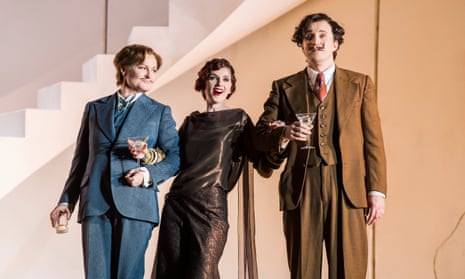This is a welcome return to English National Opera for its 2008 production of Partenope – a reminder, while the company struggles to define its identity, that it can still be a home of stylish Handel opera.
And it is the style that matters in this production. The story itself is slight, and Christopher Alden’s staging doesn’t try to pretend otherwise; but this quasi-mythical tale of a threatened queen and her confused and confusing lineup of suitors doesn’t need to be set literally on a battlefield for its points about attraction, possessiveness and jealousy to strike home. Instead, we are in the sleek 1920s residence of Partenope the society hostess, around whose flame flap five moths in the form of her spiffing suitors, including Emilio, her antagonist, who is not an invading prince but a Man Ray-style photographer who slouches in unannounced.
There is an archness to the whole thing that is lightly worn and worked into everything, including Christian Curnyn’s pacy conducting of the ENO orchestra, playing with period style on modern instruments, and also Amanda Holden’s neat, detailed translation of the libretto. In the first scene, the impending invasion by Emilio’s forces is dropped into card-table chat. “How irksome,” snaps one of the suitors; meanwhile, Partenope puts down her scotch and sashays off to find the gas masks. Images from Man Ray and his fellow surrealists pepper Andrew Lieberman’s set designs, and Jon Morrell’s costumes make Partenope a credible muse, with Marcel-waved hair and culottes wider than her cigarette holder is long. Of course, back in 2008 the suitors, with their baggy-trousered three-piece suits, their waxed mustachios and (in one case) free-range beard, looked eccentric – now all this just looks like a night out in east London.
The gender fluidity of the surrealists fits with an opera in which we have the most alpha-male of the genuine suitors played by a woman, and an “imposter” suitor, sung by a woman disguised as a man. The first, Arsace, is sung with focused intensity by Patricia Bardon, the only returning cast member from the earlier production – although then she sang the vengeful disguised ex, Rosmira, which this time gets a strong performance from the rising mezzo Stephanie Windsor-Lewis.
Looking every bit the queen bee in her sharp, cool costumes, Sarah Tynan sings Partenope in a soprano that is lightweight but incisive, and shapes her phrases beautifully once past a shaky first aria, which might have something to do with the fact that, early on, Curnyn offers his singers little if any breathing space. Countertenor James Laing is excellent as timid Armindo, sliding down the huge funnel-shaped staircase and singing his aria while he hangs off its side. The biggest break comes for tenor Rupert Charlesworth, a late stand-in for the indisposed Robert Murray. Emilio is his first major role here, and he brings to the lurking photographer strong presence and a powerful, supple tenor, perhaps not infallibly sweet-sounding but as agile and secure as his music demands. Style might win over substance in this show, but there’s nothing insubstantial about it.
- At the Coliseum, London, until 24 March. Box office: 020-7845 9300.

Comments (…)
Sign in or create your Guardian account to join the discussion